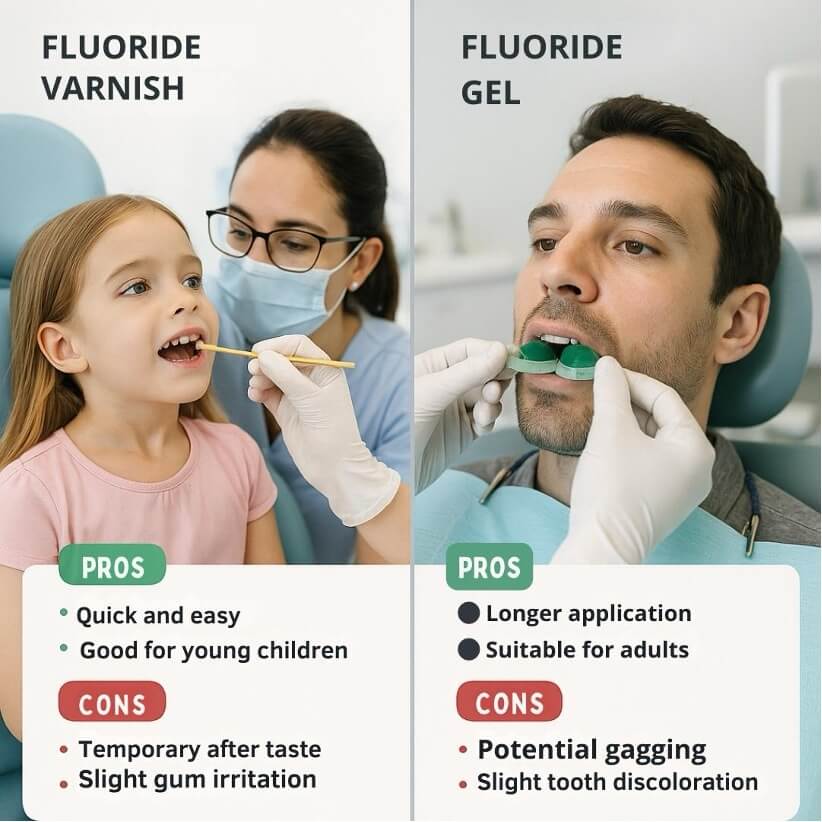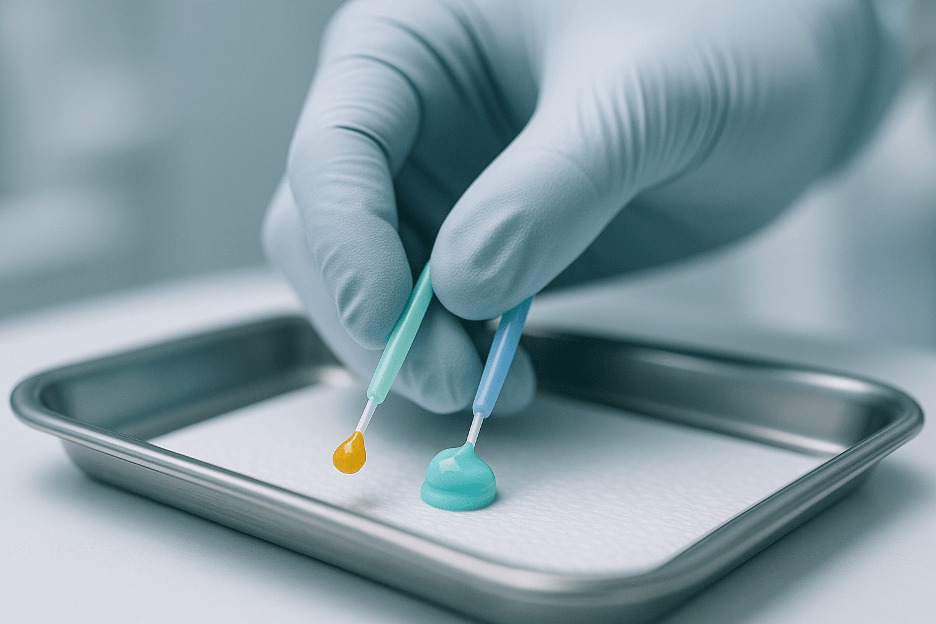Fluoride is a naturally occurring mineral that plays a vital role in preventing tooth decay and maintaining strong, healthy teeth. While many people get fluoride through toothpaste and fluoridated water, professional fluoride treatments offer an extra layer of protection. At Bur Oak Dental in Markham, we provide two common types of professional fluoride treatments: fluoride varnish and fluoride gel. But which one is suitable for you?
This guide will compare fluoride varnish and fluoride gel, detailing their application methods, effectiveness, and suitability for different patients, helping you make an informed decision about your oral health.
What is Fluoride Varnish?
Fluoride varnish is a concentrated fluoride treatment that is painted onto the surface of the teeth. It’s a sticky, resin-like substance that hardens quickly upon contact with saliva.
Application Method: A small brush is used to apply a thin layer of varnish to the teeth. The process is quick and relatively mess-free.
How It Works: Fluoride varnish releases fluoride ions slowly over several hours, allowing the teeth to absorb the fluoride and strengthen the enamel. This helps to remineralize weakened areas and prevent cavities.
Advantages of Fluoride Varnish:
- Quick Application: The application process usually takes only a few minutes.
- Minimal Discomfort: It is generally well-tolerated, even by young children.
- Effective: Fluoride varnish can reduce caries incidence significantly across all age groups.
- Versatile: Can be applied to specific areas of concern.
What is Fluoride Gel?
Fluoride gel is another type of professional fluoride treatment that is applied to the teeth using a tray or mouthguard.
Application Method: A gel containing a high concentration of fluoride is placed into a mouthguard tray, which is then inserted into the mouth for a specific period (usually 1-4 minutes).
How It Works: The fluoride in the gel comes into direct contact with the teeth, allowing the enamel to absorb the fluoride and strengthen.
Advantages and Disadvantages of Fluoride Gel:
- Broader Coverage: The gel covers all surfaces of the teeth simultaneously.
- Longer Application Time: Requires a longer application time compared to fluoride varnish.
- Potential for Messiness: Some patients may find the tray method uncomfortable or experience excessive salivation.
Effectiveness Comparison
Both fluoride varnish and fluoride gel are effective in preventing tooth decay, but studies suggest some differences in their efficacy.
- Fluoride varnish can reduce caries incidence by 50-70% across all age groups.
- Fluoride gel reduces caries by approximately 25% in adults/adolescents and 40% in children.
The effectiveness of each treatment can also depend on individual risk factors, such as diet, oral hygiene habits, and existing dental conditions.
Suitability for Different Patient Profiles
The choice between fluoride varnish and fluoride gel may depend on the patient’s age, dental health needs, and preferences.
- Children: Fluoride varnish is often preferred for young children due to its quick and easy application.
- Adults: Either fluoride varnish or fluoride gel can be effective for adults. The choice may depend on individual preferences and dental health needs.
- Seniors: Fluoride varnish may be a good option for seniors with limited mobility or difficulty using trays.
Cost Comparison
The cost of fluoride varnish and fluoride gel treatments can vary depending on the dental practice and the specific fluoride product used.
Generally, fluoride varnish tends to be slightly more cost-effective due to the shorter application time and reduced material waste.
Potential Side Effects and Safety Considerations
Both fluoride varnish and fluoride gel are generally safe when used as directed by a dental professional. However, some potential side effects may include:
- Temporary discoloration of the teeth
- Slight irritation of the gums
- Nausea (rare)
It’s important to inform your dentist of any allergies or sensitivities before receiving a fluoride treatment.
Fluoride Varnish vs. Fluoride Gel: Pros and Cons

| Feature | Fluoride Varnish | Fluoride Gel |
| Application Time | Quick (a few minutes) | Longer (1-4 minutes) |
| Application Method | Painted onto teeth | Applied via tray |
| Effectiveness | 50-70% caries reduction | 25-40% caries reduction |
| Best Suited For | Children, patients with limited mobility | Adults seeking comprehensive fluoride treatment |
| Potential Side Effects | Temporary discoloration, slight gum irritation | Temporary discoloration, slight gum irritation |
Which Option is Right for You?
The best way to determine which fluoride treatment is right for you is to consult with your dentist.
They can assess your individual needs and risk factors and recommend the most appropriate treatment option.
At Bur Oak Dental in Markham, our experienced dental team can help you choose the best fluoride treatment to protect your teeth and maintain optimal oral health.
Schedule a Consultation Today!
Ready to take the next step towards a healthier smile?
Schedule a consultation with Bur Oak Dental in Markham to determine the best fluoride treatment option for your needs.
Our friendly and knowledgeable team is here to help you achieve and maintain a lifetime of healthy smiles. Contact us today at any of our three convenient locations!
Conclusion
Fluoride varnish and fluoride gel are both effective professional fluoride treatments that can help prevent tooth decay and strengthen tooth enamel. While fluoride varnish offers the advantages of quick application and versatility, fluoride gel provides broader coverage.
By understanding the differences between these two treatments, you can work with your dentist to choose the option that is best suited for your individual needs and preferences.


